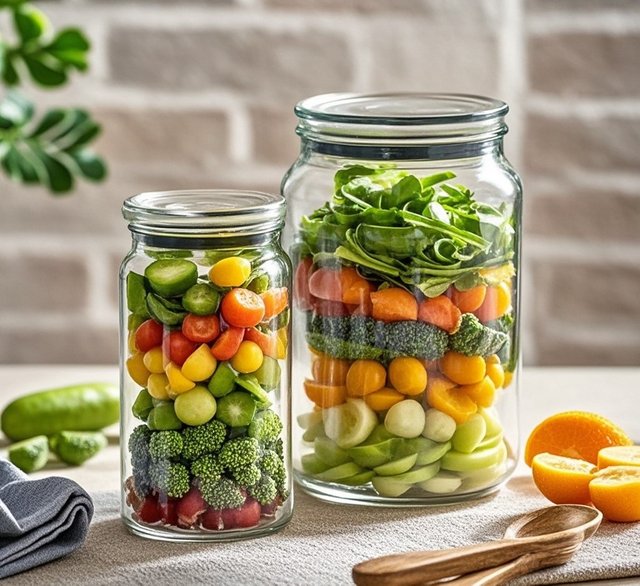There are many ways to store food. Here are the details for you:
I. Refrigeration
- Applicable foods:
- Fresh fruits and vegetables, such as apples, oranges, cucumbers, tomatoes, etc., can extend their freshness period in a refrigerated environment.
- Dairy products, such as milk and yogurt, can maintain their quality and taste when refrigerated.
- Cooked meat products, such as ham and sausage, can prevent spoilage when refrigerated.
- Precautions:
- Foods should be properly packaged before being put into the refrigerator, such as using plastic wrap, fresh-keeping bags or sealed containers to prevent odor mixing and cross-contamination.
- Different foods in the refrigerator should be placed separately to avoid mutual influence. Raw and cooked foods should be stored separately, with cooked foods placed on the upper layer and raw foods on the lower layer.
II. Freezing
- Applicable foods:
- Meats, such as beef, pork, chicken, etc., can be stored for a long time by freezing.
- Seafood, such as fish, shrimp, shellfish, etc.
- Frozen foods, such as dumplings, wontons, steamed buns, etc.
- Precautions:
- Frozen foods should be put into the freezer as soon as possible to avoid being left at room temperature for too long.
- When thawing frozen foods, low-temperature thawing methods should be used as much as possible, such as thawing in the refrigerator compartment, and avoid thawing with hot water to prevent affecting the quality of the food.
III. Dry storage
- Applicable foods:
- Grains, such as rice, flour, corn, etc.
- Beans, such as soybeans, mung beans, red beans, etc.
- Dried goods, such as mushrooms, fungus, yuba, etc.
- Precautions:
- The storage environment should be kept dry to avoid moisture. Sealed containers or bags can be used for storage.
- Place in a well-ventilated place to prevent moisture and mildew.
IV. Pickling and storage
- Applicable foods:
- Meats, such as cured meat, ham, salted fish, etc.
- Vegetables, such as pickles, kimchi, etc.
- Precautions:
- Pickled foods contain high salt content, so they should be consumed in moderation to avoid excessive salt intake being harmful to health.
- Pay attention to hygiene during the pickling process to avoid bacterial contamination.
V. Vacuum storage
- Applicable foods:
- Nuts, such as almonds, walnuts, cashews, etc.
- Cooked foods, such as marinated dishes, spiced beef, etc.
- Some dried fruits, such as raisins, red dates, etc.
- Precautions:
- Choose high-quality vacuum bags or containers to ensure good sealing performance.
- Vacuum-stored foods also have a certain shelf life and should be consumed within the shelf life.
I. Refrigeration
- Applicable foods:
- Fresh fruits and vegetables, such as apples, oranges, cucumbers, tomatoes, etc., can extend their freshness period in a refrigerated environment.
- Dairy products, such as milk and yogurt, can maintain their quality and taste when refrigerated.
- Cooked meat products, such as ham and sausage, can prevent spoilage when refrigerated.
- Precautions:
- Foods should be properly packaged before being put into the refrigerator, such as using plastic wrap, fresh-keeping bags or sealed containers to prevent odor mixing and cross-contamination.
- Different foods in the refrigerator should be placed separately to avoid mutual influence. Raw and cooked foods should be stored separately, with cooked foods placed on the upper layer and raw foods on the lower layer.
II. Freezing
- Applicable foods:
- Meats, such as beef, pork, chicken, etc., can be stored for a long time by freezing.
- Seafood, such as fish, shrimp, shellfish, etc.
- Frozen foods, such as dumplings, wontons, steamed buns, etc.
- Precautions:
- Frozen foods should be put into the freezer as soon as possible to avoid being left at room temperature for too long.
- When thawing frozen foods, low-temperature thawing methods should be used as much as possible, such as thawing in the refrigerator compartment, and avoid thawing with hot water to prevent affecting the quality of the food.
III. Dry storage
- Applicable foods:
- Grains, such as rice, flour, corn, etc.
- Beans, such as soybeans, mung beans, red beans, etc.
- Dried goods, such as mushrooms, fungus, yuba, etc.
- Precautions:
- The storage environment should be kept dry to avoid moisture. Sealed containers or bags can be used for storage.
- Place in a well-ventilated place to prevent moisture and mildew.
IV. Pickling and storage
- Applicable foods:
- Meats, such as cured meat, ham, salted fish, etc.
- Vegetables, such as pickles, kimchi, etc.
- Precautions:
- Pickled foods contain high salt content, so they should be consumed in moderation to avoid excessive salt intake being harmful to health.
- Pay attention to hygiene during the pickling process to avoid bacterial contamination.
V. Vacuum storage
- Applicable foods:
- Nuts, such as almonds, walnuts, cashews, etc.
- Cooked foods, such as marinated dishes, spiced beef, etc.
- Some dried fruits, such as raisins, red dates, etc.
- Precautions:
- Choose high-quality vacuum bags or containers to ensure good sealing performance.
- Vacuum-stored foods also have a certain shelf life and should be consumed within the shelf life.
